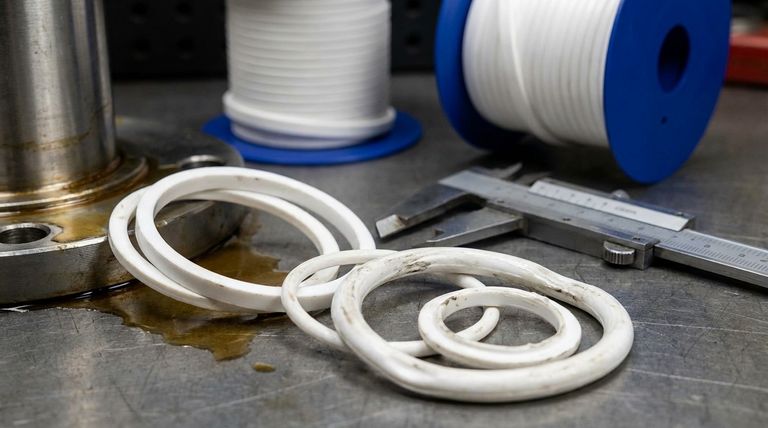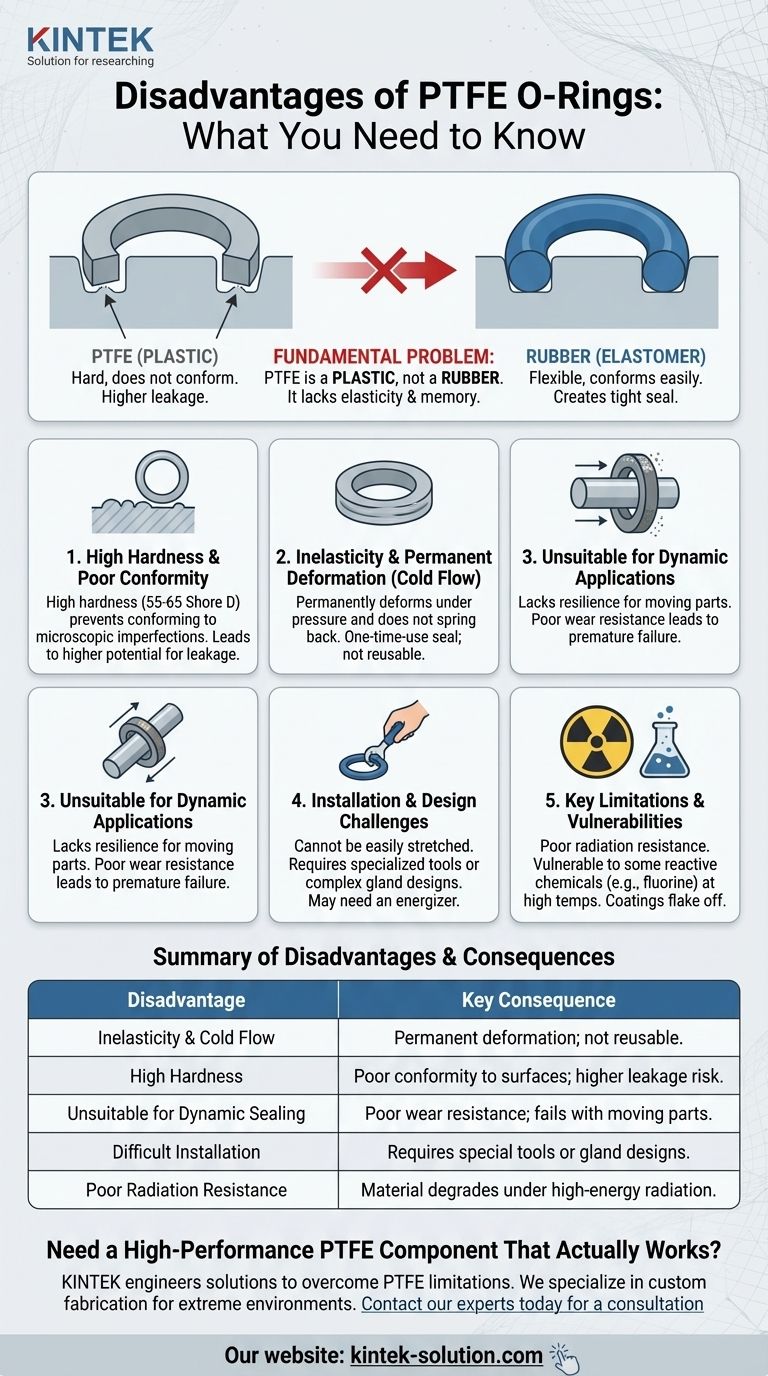The primary disadvantages of PTFE O-rings stem from their inherent rigidity and lack of elasticity. Unlike traditional rubber O-rings, PTFE is a plastic, not an elastomer, which means it is hard, does not conform easily to sealing surfaces, and permanently deforms under pressure. This results in higher leakage rates and makes them unsuitable for dynamic applications or situations requiring reuse.
The core issue to understand is that PTFE's greatest strengths—its chemical and temperature resistance—come at the cost of its sealing ability. Its plastic nature means it lacks the "memory" and flexibility of rubber, making it a specialized solution for static, extreme environments, not a general-purpose seal.

The Fundamental Problem: PTFE is a Plastic, Not a Rubber
The key to understanding PTFE's limitations is recognizing its material properties. While often sold in the shape of an O-ring, it does not behave like a typical elastomeric (rubber) seal.
High Hardness and Poor Conformity
PTFE has a high hardness, typically between 55 and 65 Shore D. This rigidity prevents the material from easily conforming to microscopic imperfections on mating surfaces.
An elastomeric O-ring will compress and fill these gaps, creating a tight seal. A PTFE O-ring cannot, which often leads to a higher potential for leakage, especially in applications with less-than-perfect surface finishes.
Inelasticity and Permanent Deformation
The most significant drawback is that PTFE is inelastic. When compressed, it does not spring back to its original shape like rubber does. This is known as "cold flow" or creep.
This lack of memory means a PTFE O-ring is a one-time-use seal. Once it has been installed and compressed, it is permanently deformed and cannot be reinstalled effectively during maintenance or reassembly.
Unsuitability for Dynamic Applications
This same inelasticity makes solid PTFE O-rings a poor choice for dynamic sealing, where parts are moving against each other. The material lacks the resilience to maintain a consistent sealing force against a moving surface.
Furthermore, its poor wear resistance means it can abrade quickly in such applications, leading to premature seal failure.
Installation and Design Challenges
The physical nature of PTFE introduces practical hurdles that must be addressed during the design phase to prevent seal failure.
Difficult Installation
Because it is not flexible, a PTFE O-ring cannot be easily stretched over shafts or into grooves like a rubber O-ring can. Installation often requires specialized tools or carefully designed sealing glands with features like retainers to get the ring in place without damage.
Potential Need for Energizers
To overcome PTFE's lack of "springiness," it is often used in conjunction with a rubber energizer (like a standard O-ring) placed behind it. The energizer provides the constant outward force needed to keep the PTFE ring pressed against the sealing surfaces, compensating for its inability to do so on its own.
Understanding the Trade-offs and Limitations
While known for its incredible resistance, PTFE is not invincible and has specific vulnerabilities that can lead to failure.
Poor Radiation Resistance
PTFE does not hold up well against high-energy radiation. Exposure can cause the material's molecules to break down, compromising its structural integrity and sealing capability.
Specific Chemical Vulnerabilities
While resistant to nearly all chemicals, PTFE can be attacked by a few highly reactive substances. These include elementary fluorine, chlorine trifluoride, and other exotic chemicals, particularly at high temperatures and pressures.
The Pitfalls of PTFE Coatings
Some O-rings are simply coated with PTFE to reduce friction. This is not the same as a solid PTFE ring and comes with its own set of disadvantages.
The coating is thin and can easily flake off or get rubbed away, especially in dynamic use. These flakes can contaminate clean systems, and once the coating is gone, it offers no further benefit. The coating also does not add chemical resistance; the underlying rubber must be compatible with the system's media.
When to Avoid PTFE O-Rings
Based on these limitations, consider an alternative material for your application.
- If your primary focus is dynamic sealing: Avoid solid PTFE, as it lacks the elasticity and wear resistance to maintain a seal between moving parts.
- If your primary focus is reusability: Do not use PTFE, as it permanently deforms after a single installation and cannot be reused.
- If your primary focus is sealing on imperfect surfaces: Choose a more compliant elastomer that can better conform to surface irregularities and prevent leaks.
- If your primary focus is a standard application: Use a more cost-effective elastomer, as PTFE's benefits are only realized in extreme chemical or temperature environments.
Ultimately, choosing a seal requires matching the material's properties to the application's demands, and PTFE is a specialist, not a generalist.
Summary Table:
| Disadvantage | Key Consequence |
|---|---|
| Inelasticity & Cold Flow | Permanent deformation; not reusable. |
| High Hardness | Poor conformity to surfaces; higher leakage risk. |
| Unsuitable for Dynamic Sealing | Poor wear resistance; fails with moving parts. |
| Difficult Installation | Requires special tools or gland designs. |
| Poor Radiation Resistance | Material degrades under high-energy radiation. |
Need a High-Performance PTFE Component That Actually Works?
Understanding the limitations of standard PTFE O-rings is the first step to specifying the right seal for your extreme environment. At KINTEK, we don't just sell parts—we engineer solutions.
We specialize in manufacturing precision PTFE components (seals, liners, labware, and more) for the semiconductor, medical, laboratory, and specialized industrial sectors. Our expertise in custom fabrication—from prototypes to high-volume orders—ensures you get a component designed to overcome the typical disadvantages of PTFE, such as cold flow, by optimizing geometry and material formulation for your specific application.
Let us help you solve your toughest sealing challenges. Contact our experts today for a consultation.
Visual Guide

Related Products
- Custom PTFE Sealing Tapes for Industrial and High Tech Applications
- Custom PTFE Parts Manufacturer for Teflon Parts and PTFE Tweezers
- Custom PTFE Parts Manufacturer for Teflon Containers and Components
- Custom PTFE Sleeves and Hollow Rods for Advanced Applications
- Custom PTFE Teflon Balls for Advanced Industrial Applications
People Also Ask
- What are the key steps for properly installing PTFE seals? Ensure a Leak-Free, Long-Lasting Seal
- What are PTFE seals and why are they considered a reliable solution for extreme environments? Engineered for Harsh Conditions
- How do PTFE seals perform under pressurized conditions? Achieving Reliable Sealing in Demanding Environments
- What are the five outstanding characteristics of PTFE seals? Engineered for Extreme Performance
- What are the benefits of using PTFE seals in demanding industries? Solve Extreme Sealing Challenges



















